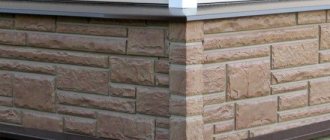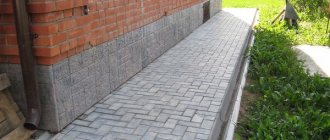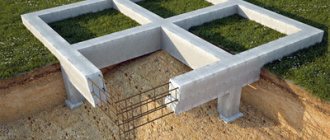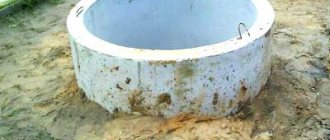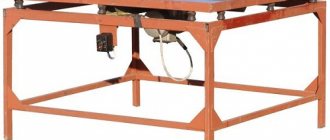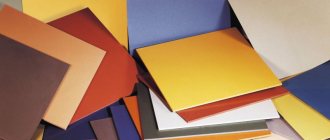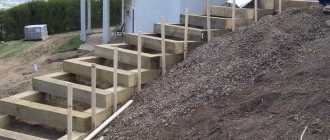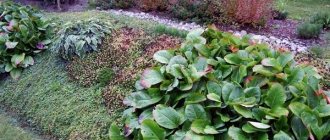The technology for manufacturing concrete products is popular in both industrial and private construction. This material can be used to fill window sills, steps for stairs, floor tiles, countertops, and so on. The main thing is that any thing can be made independently, without involving outside specialists. Let's give an example of how to make a concrete countertop with your own hands.
Like any construction process, making countertops from concrete mortar is divided into several stages. Each of them is very important; it is impossible to allow any operation to be missed.
Material selection
You can make your own sink from various materials. These include wood, acrylic, stone and concrete. But concrete products remain easy to make. This material is cheap and easy to manage.
Concrete sink
Getting a sink that matches the design is not so easy. After all the work, the concrete sink will not be inferior in appearance and functionality to a marble sculpture.
Design
The concrete countertop will be made using some tools, namely: a set of polishing pads, a woodworking jig, an electric grinder, and a device for working with concrete. Initially, it will be necessary to create an action plan, which involves creating a drawing of the future structure. You must have a clear idea of what the table will look like. You need to measure the room where you plan to place the product.
You will waste your energy if, after completing the work, you discover that the countertop does not fit in size. It is not recommended to pour out the whole monolith. The process should be divided into several stages. This will prevent the formation of cracks. In addition, moving and installing individual parts will be much easier than a solid product, the weight of which is quite impressive. When a concrete countertop is made, the master must take into account the features of the interior. This will allow us to produce a structure whose design will match the decoration.
Required tools and materials
It is important to use high-quality materials in your work. In this case, attention is paid to the concrete solution. It is advisable to choose a solution with high performance. In addition, a mold for filling is required, but you can make the mold yourself.
To make a sink with your own hands from concrete, you need the following tools to organize the formwork:
- Plastic dowels and screws 8 mm – 30-35 pieces;
- Fiberboard sheet, small trimmings are also suitable;
- A sheet of stainless material, for example tin;
- Sealant, it is better to purchase a plumbing sealant;
- Reinforcement per 100 mm – 8 rods;
- Plastic pipes for part of the drain and under the mixer;
- Polyethylene film;
- Hangers and corners of various shapes;
- Bricks or blocks that will support the weight of the formwork.
In this case, the option of not simply manufacturing the product is considered. It is much easier to make a concrete sink by pouring it with parallel fastening in place.
Before starting work, purchase the required materials. The manufacturing process requires full attention, and being distracted by searching for a screw or other tool can negatively affect the final result of the work.
To prepare a concrete mixture you will need the following materials:
- Sand, pre-sifted, washed, dried. Sand size no more than 2 mm;
- High quality cement;
- The water is warm, without impurities, it is better to take filtered or bottled water;
- For cladding you will need granite or marble chips;
- Fiber fiber, if available, it is advisable to add to eliminate cracking of concrete;
- Plasticizer of any brand, additive for waterproofing.
It is advisable to use concrete grade M400 and higher.
For cladding I use the following materials:
- Tile mosaic tiles;
- Grout on seams with a waterproof effect;
- Mold resistant tile adhesive.
To make a sink with your own hands from scrap materials you will need the following tools:
- Jigsaw, electric circular saw;
- Vibrator for concrete;
- Screwdriver;
- Hammer drill with drills for concrete 8-10 mm;
- Hammer;
- Welding machine;
- Scissors capable of cutting metal;
- Grinder with a diamond-coated disc;
- Level and tape measure to control measurements;
- Mixer for mixing concrete;
- Construction pencil for markings;
- Rule;
- Pipe gun;
- Metal lighthouse;
- Container for stirring the solution;
- Plastic tile crosses;
- Rubber spatula;
- A comb to apply the glue evenly.
Monumental furniture
Stone is a traditional material for garden compositions.
There is little mention of stone furniture sets in the article. Objects made of stone or concrete, used utilitarianly, are not ordinary furniture that can be easily replaced if out of fashion, or simply shoved into the attic and forgotten.
You cannot easily move a stone bench from place to place without the use of special equipment or at least the efforts of several people. When purchasing monumental garden furniture, it is better to think through the overall composition in advance so that it fits into the design of the site.
Benches and a table made of stone can be made in the style of the fence or the house itself, complemented by elements made of metal or wood. It’s good when utilitarian objects are effectively combined with plants. Most importantly, garden furniture should support a unified design style of the site.
To make a bench or table from stone, it is not necessary to turn to master stone-cutters or buy expensive and rare varieties of granite or marble. The natural beauty of stone lies in a simple cobblestone, a block of limestone or sandstone. And the options proposed as an example are quite accessible for independent implementation.
Stone garden bench. Photo from landartdesign.com
Interesting varieties of garden furniture using natural stone are also opening up another fashionable trend in -.
Garden bench using gabions. Photo from remstd.ru
Metal mesh can be filled with any available stones and used as bench seat supports or underframes.
Formwork production and fastening
Before you begin assembling the formwork, select a location for the future sink.
The choice of shape for the sink remains arbitrary. You can make formwork of any size and shape, the main thing is that it is smooth and strong. If the shape of the sink suggests the presence of smooth curved sections, then it is better to make them from a sheet of iron.
Also, it is recommended to make the womb itself from tin. As soon as the formwork is assembled, all that remains is to go over the seams with sealant, this action is necessary to prevent the solution from leaking.
After the formwork is completely assembled, all that remains is to fasten it to the selected location on the wall. The wall must be strong enough to support the weight of the concrete. A good option would be to mount the sink in the corner, this creates additional support area.
The fastening process takes place in several steps:
- Drill holes in the wall for the structure's reinforcement. It must be located somewhere in the middle of the intended shape. The frame is welded or tied with wire.
- The formwork is securely attached to the wall using corners and screws.
- On the back side of the wall, several iron sheets are welded to the reinforcement. This will make the structure more reliable.
- Under the formwork a podium is made of bricks and blocks. It must be strong and stable.
- Clean the formwork from dirt. It is also worth checking the evenness of the structure and its stability.
When attaching formwork, the main criterion is stability and evenness. If there is a slight tilt, the sink will also be at an angle.
Carrying out polishing
After completing all the work described above, you will get a dark countertop, the shade of which will be slightly different from concrete. The final stage will require polishing. In this case, the working element must be constantly wet. There is no need to rush. Movements should be uniform and slow. If you are thinking about how to cover a concrete countertop, you can find out by reading the article. Gradually, grinders change in grit size. This is done until 1500 units can be reached. You can find polishing pads with a grain size of 3 thousand units. But in order to cover the surface with primer varnish, you should make the base as smooth as possible.
The production of concrete countertops ends with the application of a primer varnish. It should be allowed to dry thoroughly. To achieve a positive result, the varnish can be applied in several layers. And then the surface must be cleaned with a wax composition, after which has hardened, the tabletop is wiped with a clean rag.
Making a solution for the sink
It is better to mix the concrete solution with a special mixer. This should not be done in a concrete mixer. Only a mixer can ensure good mixing of products.
The solution is prepared according to the following scheme:
- Add the required cement and only 1/8 of the liquid. Mix everything, making sure that no strong lumps or areas of dry concrete form.
- Then add plasticizers and fiber. To stir thoroughly.
- Add sand and granite chips. Stir and ensure homogeneity.
- Add the rest of the water and finally mix the ingredients.
Concrete should not be made plastic. This may reduce its performance. The mixture should be hard, this will make the finished product high quality.
Also, if it is planned that the bottom of the sink will be directly in the concrete, and not made of another material on top of it, then it is worth pressing a bowl into the concrete to the required depth, and insert a small pipe under it. Before doing this, they need to be greased or wrapped in cling film.
Making colored concrete: 3 ways
- Dye as a component of the concrete mixture - powdered pigment is added to concrete during the mixing process. This way the color is distributed evenly throughout the entire depth of the slab. This is the most common and reliable method of coloring concrete; the range of colors is almost limitless.
- Acid staining is a less predictable option that makes the process of concrete interacting with metal salts a little magical. This painting is performed on hardened slabs; the color of the countertop will constantly change, but the choice of shades is small compared to the previous painting method.
- Paint is a liquid dye that is applied to the finished slab and penetrates only into the top layer of concrete. Not all paints are UV resistant.
If you already know how the countertop will be installed, you can choose the most appropriate staining option.
Pouring concrete
Concrete is first poured into the most inaccessible places. It must be constantly vibrated so that the mixture is distributed evenly. After completely filling the formwork, you need to level the surface and cover the sink with film.
After 3 days, the concrete will completely harden. You can remove the film. After the same period of time, the formwork is removed. But the installation of taps and siphons is postponed for a month. This is necessary so that the product dries completely and becomes strong.
Finishing
After removing the formwork, the wall will have a finished product. But the sink still needs to be processed and brought to its final form. This is done either by sanding or tiling.
If it is just grinding, then before starting the work you need to cover up the unevenness and cracks with concrete paste. After the paste has dried, start sanding. Here everything is done individually. You can bring the surface to perfect smoothness using a grinding machine, and also leave a slight roughness.
Tiling does not require the removal of minor imperfections. The tiles are laid like tiles. But don’t skimp on glue and grout.
The shell bosom can be filled with epoxy resin. For beauty, it is recommended to pour granite chips there. When the resin hardens, you will get a smooth surface.
Work methodology
The mesh rises above the surface of the mold base by 25 millimeters. The easiest way to do this is with wire. Great importance should be paid to decor. To make it attractive, you need to prepare transparent, brown and green glass, which breaks into fragments. If you wish, you can use coins, pebbles and other items.
The tabletop will look original with To do this, you need to drill holes in the plastic sheet of the mold. The cable is installed in them. Gaps should be filled with sealant. The ends of the cable will hang below the form. They need to be collected in bunches. Later, light elements are inserted into them, which will create the effect of a starry sky. Glass shards can easily become dislodged when pouring the solution. To prevent this, you should fix them with spray glue.
Features of the material
A designer sink costs a lot of money, but because all the concrete components are available, the price of a DIY sink will pleasantly surprise you. The advantages of concrete for making sinks are obvious.
To obtain a smooth, elegant concrete surface of the sink, it is recommended to use M300 sand concrete instead of heavy concrete with coarse aggregate.
Better installation and creation of a smooth surface will be facilitated by adding a plasticizer to the solution. Concrete sinks in the interior of a kitchen or bathroom always look stylish and modern.
Important! If it is necessary to give a concrete sink a particular color, it is necessary to use special pigments and dyes for this material, which can be added to the solution at the stage of its preparation or allow for high-quality coloring of the surface after it has been sanded. It is worth noting that when using white cement the shade will be richer.
Recommendations for choosing the main components of a concrete mixture for making a sink:
- To produce a high-quality and beautiful product, it is recommended to use cement M400 - M500;
- As an internal filler, it is recommended to use clean fine sand (from 1.2 to 2 mm), which must first be washed and dried;
- The concrete mixture is prepared in the traditional way in a ratio of 1:3 with a water-cement ratio not exceeding 0.5, depending on the brand of cement. Instructions for plasticizer dosage are provided by the manufacturer;
- The consistency of the finished mixture can be compared to wet sand after rain; it should be plastic to the touch.
Advice. If there is no vibrating table and plasticizer, then you can evenly tap the formwork until the cement laitance comes out.
Formwork material
For the manufacture of formwork, it is recommended to use fiberboard bars or sheets of the required size, boards or plastic sheets, the thickness of which does not exceed 2 mm. It is important to make high-quality formwork for the sink bowl. If the original shape of the product is assumed, then the best solution would be to use galvanized steel sheets.
To make the structure monolithic, durable and securely fastened to the wall, it is necessary to use reinforcement in the form of steel rods with a diameter of 10 to 15 mm.
Important! The fittings are laid in increments of 20 to 40 cm (for the countertop), and under the sink bowl it must be laid in increments of 1.5-2 times more often.
It should be taken into account that a sink made of reinforced concrete has a high weight, so it can only be securely fastened to a strong supporting structure of the building. To do this, the reinforcement is inserted into a concrete, reinforced concrete or cinder block wall with the condition of through penetration. When calculating the length of the reinforcement, the thickness of the load-bearing wall is taken into account.
For example, if the structure has dimensions of 1 X 1.2 m, and must be attached to two concrete walls with a thickness of 250 mm, it is necessary to make a longitudinal laying of 2 reinforcement rods 1.45 m long. The transverse laying, taking into account the sink, is carried out using 4 reinforcing bars 1.25 m long. As a result, the metal reinforcing bars will have a total length of 7.9 m.
The formwork must be strong and monolithic, especially at the joints; for this, the use of corners, sealant and metallized tape is recommended. To fasten the formwork elements you will need to use dowels and self-tapping screws.
The structure should dry under plastic film. Also, it is necessary to install temporary supports that will withstand the high weight of the structure while the concrete gains strength. It is recommended to use bricks for these purposes.
Exterior finishing and tools
Exterior finishing can be done using tiles. To do this you will need to purchase tile adhesive and grout. It is possible to use cement mortar with decorative filler.
Minimum set of required tools:
- To make formwork, it is recommended to use an electric jigsaw or other tools with a similar function (a regular hacksaw will not cope with the upcoming amount of work);
- In order to drill holes for reinforcement with a diameter of 10 to 12 mm and for formwork dowels with a diameter of 6 to 8 mm, it is necessary to use a hammer drill with concrete drills;
- You must have a screwdriver or screwdriver, a hammer and metal scissors;
- To securely fix the fittings, you will need to use a welding machine;
- To mix the concrete solution, it is necessary to prepare a container of the required volume;
- A construction mixer will allow you to mix all the components of the composition evenly;
- Measuring tools will require a ruler, tape measure, building level, plumb line and pencil;
- To apply the solution, you must have spatulas of various sizes.
Making kitchen countertops from marble
To make a marble countertop yourself, you need to think about the shape of the finished product. As a standard, it can be a rectangular tabletop, square, oval or rectangular in shape, with rounded edges.
In this case, in order not to complicate our task, we will cut a rectangular tabletop from gray marble. The stone can be processed, but you just need to get a special tool. Back in the last century, craftsmen used hand tools to cut the desired figure from a monolith. Nowadays, you can make your task easier and cut anything out of stone using the waterjet method of processing natural material. Of course, this type of tool will be needed for larger-scale work, and when it comes to small work, then you can get by with improvised tools (drill, grinder).
A popular tool for working with natural stone is an angle grinder or angle grinder. You just need to also acquire a set of discs designed for cutting stone. It must be taken into account that such a power tool is very sensitive to shock, that is, when working with hard natural materials, the tool can quickly fail. In this case, it is necessary to think through the dust removal system in advance and change the diamond disc more often. It is better to take discs with bronze, 6 mm thick.
If you need to cut grooves, then you will also have to purchase a curtain cutter - this is a special high-speed power tool into the grooves of which you can insert 2 discs at once.
The procedure is as follows:
- First, you need to prepare the surface, that is, using a circle with a film base (microabrasive), you need to sand the surface. The rotation speed of such circles is very high, so you can quickly smooth out a convex surface, because a monolithic absolutely smooth stone is rarely found in nature.
- Just after the initial processing of marble, you need to decide immediately and clean the surface with a grinding tool in order to achieve ideal smoothness (polishing effect) or make the countertop matte.
- Since our task is to cut a rectangular tabletop from stone, it is easier to process a flat surface with an orbital sander. And to achieve a glossy shine, you can use a special polishing paste.
- You can cut a tabletop of the required size from a monolithic stone using a standard set of hand tools: a sledgehammer, a hammer, a pick. But since this is too difficult and time-consuming, it is best to complete all the work on a special machine. If it is not possible to purchase such a machine, then try to find a way out of the situation. A powerful grinder with diamond blades is suitable for working with natural marble. Also, in order to prevent the stone from splitting and damaging the tool, experts recommend working at medium speeds and only occasionally turning on the saw at high speeds. To prevent cracks from appearing on the surface, think ahead and ensure a continuous supply of water. Just water will help to avoid overheating of the power tool during operation.
Since natural marble is a very expensive material and difficult to process, most people choose an alternative option - countertops made of artificial stone. Artificial marble has many advantages: it is affordable and easy to work with. Anyone can make a marble-like artificial stone countertop.
What does the term “artificial marble” mean? These are mineral fillers and acrylic resin. As a result of high-temperature processing, a solid material is obtained. Visually distinguishing a fake from the original is almost impossible. You can understand that this is an artificial marble countertop in front of you: place your hand on the surface - you will feel a pleasant warmth. Marble is a cold stone and practically does not heat up.
Continuing the list of advantages of artificial stone, we can note its high degree of wear resistance. You can safely place hot dishes directly on the marble countertop; nothing will happen to them. And if you accidentally spill wine or coffee on the gold marble countertop, there will be no stains. Artificial marble does not absorb liquids, so there is no need to worry about unsightly streaks and stains remaining on the countertop.
And some more information about the features of artificial marble:
- The material does not burn and does not conduct heat or electric currents. That is why artificial marble is widely used not only for the manufacture of furniture, but also for interior items (figurines, fireplaces, radiators). By the way, if you put an unextinguished cigarette on an artificial stone countertop, nothing will happen. The surface will remain intact.
- It is not afraid of treatment with chemicals; the use of household chemicals and various liquids (solvent, acids, acetone and even gasoline) is allowed.
- The surface structure is solid, so the countertops can withstand any force.
- The artificial material does not delaminate and does not rot. It is highly resistant to stains. The surface can be cleaned using any detergent.
- Liquids such as tea, coffee, wine, and juices are not harmful to artificial marble.
This is why most practical owners choose artificial marble countertops.
The process of making a concrete sink
You don't need any specific construction skills to make your own concrete sink. It is enough to follow the sequence of work performed.
The video in this article will tell you how to make a concrete sink with your own hands.
Preparation
First, you should make a sketch of the product with dimensions in order to determine the volume of material. The walls where the sink and concrete countertop will be located must be cleared of furniture and paint, plaster or other decorative coating must be removed from their surface.
Markings are applied to the prepared wall surfaces using a pencil, indicating the location of the structure.
Formwork
To simplify the work, it is recommended to make a mock-up of the structure in natural dimensions. For this purpose, it is possible to use ordinary thick cardboard. When the layout is ready, we begin to make a blank for the sink bowl.
The base and sides of the formwork structure of the required size are cut out from pieces of chipboard or other material. Then they are secured in accordance with the previously made layout, using self-tapping screws and metal corners. The joints are treated with sealant.
Important! At the stage of forming the formwork structure, it is necessary to provide holes for draining and overflowing water. To do this, plastic pipes of the required diameter are inserted into the formwork at the locations of the bowl.
Armature
Using a hammer drill and a drill of the required diameter, it is necessary to punch the required number of through holes for the reinforcing bars in the load-bearing wall. The holes should be positioned so that the reinforcing bars are located in the middle of the concrete countertop and sink structure.
The reinforcing bars that will be located under the bottom of the bowl must be given the appropriate configuration by first bending them.
In order for the reinforcement to be securely fastened in the load-bearing wall, a steel washer must be welded to the end of each rod, which will be fixed into the drilled hole. To do this you need to use a hammer.
The entire structure must be connected by welding in the places where the rods intersect. If you don’t have a welding machine, then in these places you can tie the rods together with wire.
Exploitation
Like most work surfaces, concrete countertops can only be cleaned regularly with warm water and soap using a soft cloth. Abrasive cleaning products are best avoided.
The lifespan of your countertop depends on choosing the right sealant.
Sealants can be of 2 types:
- Penetrating sealers soak into the concrete and are virtually invisible once dry. They do not protect the concrete surface from spilled liquids, but they do prevent liquids from penetrating into the concrete. This means that a stain may remain on the countertop, which is excluded when using local sealants.
- Topical (localized) sealants such as wax, silicone and acrylic change the appearance of the countertop and its surface properties. Epoxy sealants create a fairly thick and durable glossy layer. Beautiful in appearance and easy to use, wax does not work well as a sealant. The acrylic coating looks great and has a good set of characteristics, but such a tabletop is easy to scratch.
We believe that it is impossible to determine the ideal sealant for a concrete countertop. Using the information provided in our article, you can choose the type of sealant that suits you best.
Concrete is practically indestructible, while sealant is not. The sealant can be damaged by cutting kitchen tools, aggressive cleaning agents, acids, and hot dishes. Treat the surface of your countertop with care, use cutting boards and coasters for hot dishes. Then the sealant will last a long time and will not become a breeding ground for harmful microbes.
Manufacturing a concrete countertop for a sink based on an existing laminate structure
To create a modern look for your kitchen interior, it is not necessary to dismantle the existing furniture. You can make a stylish concrete countertop using an existing laminate surface as a base. This will require a concrete mixture used for floor screed, which is applied to the surface of the countertop.
This method of updating an old, scratched, damaged countertop will update the interior, breathe new life into it, creating an atmosphere of industrial style.
Materials and tools
To carry out the work you will need the following:
- You need to purchase a concrete mixture for screed at a hardware store. One bag (4.5 kg) should be enough for a medium-sized tabletop;
- A set of spatulas of different sizes, the large one should be at least 20 cm, and the small one should be from 5 to 10 cm;
- A container for preparing the solution and a wooden stick for stirring the mixture;
- For grinding, you will need to purchase sandpaper of different grits - 20-N, 25-N, 5-N and M28N-2;
- For personal protection, you must have a painting mask or respirator;
- Requires sealant, liquid to strengthen the concrete surface and varnish
Below is the sequence of work:
A washbasin built into the countertop looks much more interesting than one standing separately, without any decoration.
And it’s more convenient to use - cosmetic accessories or a razor can be placed nearby, rather than held in your hands.
Many users will be interested in a homemade countertop in a bathroom made of tiles - this will be discussed in detail below.
Concrete countertop with bathroom sink and coffee table in black
There is also a ready-made example on the forum of a concrete countertop with a bathroom sink.
Anrushka1 FORUMHOUSE Member
The sink is made of concrete, sand, screenings and cement, decorative elements and pebbles are visible on top, I regret that I didn’t add more of them. I made the formwork, reinforced it, poured it, when it dried - sanding with a rough wheel, then with flexible “turtles”. As a finish, it was coated with varnish for exterior use, which I also regretted; ordinary varnish, after prolonged exposure to water, begins to glow with blue highlights. It needed to be coated with polyurethane.
The craftsman first sanded the main surface with a grinder with a hard wheel; for the next stage of work, a grinding machine was required; hard-to-reach parts were sanded manually. For the future Anrushka1
He advises everyone to treat such areas with their hands until the concrete for the countertop has completely set, and with a grinder only when it has hardened. You will have to purchase several “turtles” for fine grinding.
Anrushka1
You need to take from the smaller grains and in order, you need to use everything, jump over only after 800 and then not much, you will kill the turtle quickly. They also come in sizes less than 1500, 2000, 3000, but since I varnished, the last 1000 was enough for me.
If you no longer want to see ordinary ones in your kitchen or any other room of the house, you can order an expensive marble analogue. However, you can make such a product yourself using concrete. As practice shows, the design looks very attractive. And you can decorate it with different elements, including glass. After completing the work, you will be able to get a unique table that will cost very little.
Advantages and disadvantages
The following arguments speak in favor of a homemade countertop with ceramic cladding:
- affordable price . Branded granite and marble countertops, especially those made to order according to consumer sketches, are much more expensive;
- diversity. There are countless types of tiles on sale with different textures, colors, patterns and surface types. This allows the home designer to create an exclusive product that fits perfectly with the bathroom interior;
- excellent characteristics. Ceramic tiles are moisture-resistant, durable, stable to temperature changes, and are easy to keep clean. Porcelain stoneware has the best characteristics: due to the absence of pores, it is close to natural stone in terms of strength, wear resistance and water resistance.
Tools and materials
To make a tabletop you will need the following arsenal:
- drill with impact mechanism;
- jigsaw;
- tile cutter for shaped cutting (you can order tile cutting in the workshop);
- levels: rack and bubble;
- roulette;
- crosshead screwdriver;
- brush;
- spatulas for laying tiles: metal (solid and serrated), rubber.
The following materials are used:
- galvanized profiles for plasterboard structures: guide and rack;
- for supports: profiled pipe or brick;
- moisture-resistant plywood (FSF);
- moisture-resistant plasterboard (GKVL) or cement-bonded particle boards;
- tiled or porcelain tiles;
- tile adhesive.
You will also need a fungicidal grout (with an antifungal additive).
Tile sizes
In ceramic cladding, the seams are a weak point, so it is advisable to use tiles that are as large as possible. But in a small room, large modules look bulky and emphasize cramped spaces.
It is recommended to use tiles of the following sizes:
- in a spacious bathroom: from 30x30 cm to 60x60 cm or mosaic (5x5 cm or less);
- in compact: from 10x10 cm to 20x20 cm.
The use of concrete in the manufacture of furniture
Typically, concrete is associated with foundations, floors, screeds, stairs and similar massive products that are subject to high loads during operation. Initially, only garden furniture was made from concrete, but today it is also successfully used for home furniture. The most common are monolithic kitchens, in which not only the concrete countertop is cast, but also the partitions. However, there are also:
- concrete kitchen islands,
- sinks with portals for bathrooms,
- coffee tables,
- consoles,
- shelves,
- window sills,
- computer tables.
Such furniture is made either entirely from concrete or in combination with wood or other materials.
The composition of the solution is selected based on the scope of application, but in most cases it is a cement-sand mixture (CSM) with the addition of plasticizers. Depending on the desired result, various fine fillers are also introduced:
- crushed stone,
- granite,
- marble chips,
- coil and others.
In large products, such as countertops or consoles, a metal mesh or reinforcement frame (metal or composite) must be used.
Formwork for pouring is made either from smooth sheet materials (sheets of plywood, laminated plywood, laminate, chipboard) or from boards, but for better formwork, the board is covered with thick plastic film.
There are two methods of casting - direct and reverse, in the first case the formwork is assembled on site, and the top of the pour will be the front side, in the second - the form is assembled and poured separately, when installed, the bottom becomes the top. Backfilling makes it easier to achieve a smooth surface and reduces finishing labor.
As in the case of sanded floors, this finishing allows you to reveal the structure, add gloss and significantly increase the surface's resistance to abrasion.
On our portal, the topic of concrete furniture was discovered several years ago by a participant with the nickname Dobermax, who shared the technology of pouring a console tabletop with his own hands for a computer desk made of concrete.
Frame preparation
The tabletop frame is formed as follows:
- markings are applied: on the wall 80 cm from the floor, draw a strictly horizontal line with a marker, having previously marked the extreme points using a bubble level; a rectangle is drawn on the floor, repeating the outline of the tabletop. A sign of the absence of distortions is the equality of the diagonals of the drawn figure;
- mark the position of the brick supports and remove the floor tiles in these places, having previously cut them along the contour with a grinder. The tool is equipped with a metal disk for dry cutting of stone (segmented);
- walls are erected from bricks to the level of the line drawn on the wall, fixing them with cement-sand mortar. Such supports are good because they allow you to install shelves and doors;
- The brick supports are plastered and a day later they are covered with tiles. It is important to do the finishing at this stage, since after installing the countertop it will be more difficult to implement;
- they make a frame from CD profiles for plasterboard structures. To make the frame stronger, each element is made of two profiles, inserting one into the other (they have a U-shaped section). The result is a prefabricated profile with a box-shaped section. Metal elements are fastened together with blind rivets or metal screws;
- Several cross members from the same profile are fixed in the frame to add rigidity;
- lay the frame on supports and screw one side to the wall using dowels.
In addition to stone supports, they use:
- racks made of profiled pipe with section dimensions 50x30, 40x40, 60x40 mm or purchased chrome;
- welded brackets from the corner, transferring the load from the tabletop to the wall (suspended version).
Manufacturing technology for a table with a concrete top
Making an action plan
Decide on the design and appearance of the table. Measure the room where you plan to place the finished table. There is nothing worse than finishing work and realizing that the table simply doesn’t fit. Do not pour out a solid concrete countertop. It is better to split the process into several stages. This will help avoid the formation of cracks, and it is easier to move and install parts of the product than a solid concrete countertop. When designing a table, take into account the style of the interior and try to ensure that the product matches it: making tabletops from polished concrete also requires artistic vision. In our case, we consider the manufacturing process of a relatively small, fairly modern corner table.
Building a table frame
We will not describe in detail the principle of creating a frame, since the design of each table will be unique.
The fronts of our table are made of laminated plywood; its tabletop rests on two cabinets. There is a drawer in the middle. The supporting elements of the frame were made of hardwood boards. To create fronts and drawers, a sheet of laminated plywood must be cut.
Creating a mold for pouring a concrete countertop
The base of the mold will be plastic sheets 18 mm thick. Sides with a height of about 50 mm are mounted around the perimeter. Thanks to this height, it is possible to pour the layer of concrete necessary to provide the required strength.
When making a mold, be guided by the dimensions of the frame. At this stage, everything must be done very carefully and precisely, because after pouring the concrete there will be no turning back. Fill the joints between the plastic sheets and the sides with silicone sealant. It will prevent liquid concrete from leaking out.
We lay the reinforcing mesh and decorative elements
At this stage, it is necessary to strengthen the future tabletop with wire mesh and lay out decorative elements (colored broken glass is perfect), which, after processing, will appear on the surface of the concrete.
If there are going to be any holes in the countertop, now is the time to take care of them. To do this, wrap a ring made of PVC pipe in polyethylene and place it in the right place. After the concrete has hardened, the pipe can be pushed out, after which the polyethylene can be easily removed. The mesh should be raised above the surface of the mold base by approximately 25 mm. The easiest way to do this is with wire. In our case, shards of green, brown and transparent glass were used as decorative material. If desired, you can use pebbles, coins and other interesting items. We decided to be original and use fiber optic cables. To do this, small holes were drilled in the plastic sheet of the mold, cables were inserted into them, and the gaps were filled with sealant. The ends of the cables hanging under the form must be collected into bundles. Later, they can be inserted into light boxes to achieve backlighting with a “starry sky” effect.
To prevent glass fragments from moving when concrete is poured, they need to be fixed with spray glue.
Pouring concrete
Preliminary preparations are completed, now you can prepare the concrete. Thoroughly mix cement and sand in a ratio of 1 to 3. Add water until the mixture has the consistency of thick oatmeal.
Carefully pour the mixture into the mold. Fill it halfway and spread the mixture evenly throughout the pan. Shake the pan well to remove any air bubbles inside the mixture. Mix another batch of concrete using the same proportions, but this time add a fair amount of fiberglass. Pour the mixture into the mold. Pull the surface together using the rule. Let the concrete dry for a day and then cover its surface with damp towels. This will help slow down the hardening process and have a positive effect on strength. You can remove the blanks from the mold after 2 days, but it is better to wait another day. Our concrete was quite thick, so we couldn't effectively remove all the air bubbles from it? As a result, the surface of the countertop turned out to be porous? This can be fixed. To remove the blanks from the mold, it must be disassembled. Start by removing the sides and then flip the slab over so the plastic sheet is on top. Pry up the edge of the sheet with a spatula. If necessary, use a brick as a support to create leverage.
Grinding and filling pores
The porous surface of the slab must be sanded. This is done so that fragments of colored glass and other decorative elements embedded in the concrete appear on the surface. Sanding also helps smooth out nervousness, remove residual spray glue and open up surface pores. To perform this operation, wear clothes that you do not mind getting dirty. After sanding, let the slab dry.
Mix the cement with the acrylic fixer until a homogeneous, not too thick mass is obtained. It is better to apply the resulting mixture in three stages, since some shrinkage of the material occurs when it dries. Spread the acrylic-cement mixture evenly over the surface, filling all voids and crevices. Let the mixture dry and remove all protrusions and roughness from the surface.
Repeat the operation again, try to fill the holes and voids that were missed when applying the first layer.
After applying the third layer, there is no need to remove the remaining mixture and roughness from the surface. Leave the slab to dry overnight. Then sand the surface with the coarsest polishing pad (about 50 or 100 grit). Carefully inspect the surface for holes or voids that have not been filled with the acrylic-cement mixture. If necessary, apply another layer of the mixture.
The surface must be smooth: pores filled with the mixture may appear darker than the concrete.
Polishing
When polishing, you need to ensure that the polishing pad is constantly wet. Polish the countertop surface slowly and evenly, using different polishing pads up to 1500 grit. There are polishing pads with a grit of 3000 units, but the surface of the tabletop must be coated with a primer varnish, and for good adhesion the surface should not be perfectly smooth. After sanding, apply primer varnish to the surface of the countertop and let it dry. You can apply the varnish in several layers. Rub the surface with wax. After the wax has hardened, wipe the countertop with a soft, clean cloth or towel.
Assembling the table
The table is assembled using bolts. Place a concrete countertop on top of the frame, install drawers, and run extensions.
If you want to achieve the “starry sky” effect, you need to make light boxes and connect bundled fiber optic cables to them.
If you no longer want to see ordinary ones in your kitchen or any other room of the house, you can order an expensive marble analogue. However, you can make such a product yourself using concrete. As practice shows, the design looks very attractive. And you can decorate it with different elements, including glass. After completing the work, you will be able to get a unique table that will cost very little.
Sheathing
- From a sheet of moisture-resistant plywood of the FSF brand with a thickness of 19 mm, cut out two identical blanks and glue them together, laying them on top of each other. If the design of the tabletop involves curved outlines, cutting is done with a jigsaw;
- lay the plywood base on the frame and screw it to it with metal screws;
- glue onto the top and ends of the plywood a material similar in thermal expansion coefficient to ceramic tiles. For plywood, this indicator is very different, so you cannot glue tiles directly onto it.
The following materials are used:
- cement particle board (CSB) with a thickness of 6 – 13 mm;
- moisture-resistant plasterboard sheet (GKLV).
When cutting with a grinder, the DSP generates a lot of dust. It is more correct to make cuts with a construction knife and then break the slab on the corner of the table. If necessary, the ends are ground. The DSP is screwed to the plywood with self-tapping screws, having previously countersunk the holes so that the caps are flush.
The following manipulations are performed with the gypsum board sheet:
- glue it to the plywood with tile adhesive and additionally fix it with self-tapping screws;
- apply two layers of nitro varnish diluted with nitro solvent on top and on the ends;
- fill the joints with silicone sealant “For aquarium” (excess is immediately removed);
- seal the joints with sickle tape;
- apply 2-component automotive putty (the cheapest one will do) with a thickness of 1-2 mm on top and on the ends with a medium-width spatula;
- After waiting for the putty to harden (it takes about an hour), sand it with coarse sandpaper, wrapping it around the block.
Next, an opening for the sink is cut out at the base using a jigsaw. In the case of using gypsum plasterboard, this is done before applying a protective coating of nitro varnish. Modern sinks are equipped with a template - the opening is cut out from it.
In the absence of a template, you will have to make it yourself. To thread the jigsaw blade, drill a small hole on the contour of the opening with a drill.
Laying decorative elements and frame systems
A concrete countertop should not only be aesthetically attractive, but also as durable as possible. To do this, you should use wire mesh. Decorative elements should be placed at the bottom. Broken glass can play their role. After surface treatment, the decor will appear and become visible on the base.
The concrete countertop may have holes for laying communications. If this is the case, then their presence must be indicated at this stage. To do this, you can use a ring made of PVC pipe. The workpiece is wrapped in polyethylene and placed in the designated place. After the concrete hardens, the pipe is pushed out, and the polyethylene will be easy to get rid of.
Tiling
Tiles for countertops are selected according to the following criteria:
- type . The surface of the countertop is not subject to significant loads, so wall tiles are sufficient (there is an icon with a hand on the package);
- surface . Relief tiles look interesting, but they are difficult to keep clean: dirt is firmly held in uneven areas;
- color . All shades of blue, reminiscent of the sea, are always appropriate in the bathroom: azure, turquoise, sea green. You can add white or make the tabletop red and black.
Tiling is done as follows:
- treat the surface of the base of the tabletop with a latex-based primer - it will increase the adhesive strength of the glue. Work continues after the primer has dried, which takes a day;
- The glue is applied with a spatula with a straight blade. For leveling, notched spatulas are used, which have different tooth heights; this determines the thickness of the adhesive layer. Typically, tile adhesive manufacturers indicate on the packaging which spatula to use to apply the mixture when gluing tiles of different sizes;
- lay the tiles on the layer of glue, using a slatted level to mark the horizontal position. The method of gluing the mosaic depends on the type of flexible base: the synthetic mesh should be on the bottom, the paper mesh on top. After the glue has hardened, the paper is soaked and removed;
- Apply glue again and glue the next module, inserting plastic crosses into the seam between it and the previous one. Cross stitches ensure that all seams are of equal width. When gluing mosaics, select crosses with a width equal to the width of the seams between the chips. The glue that comes out of the seams is wiped off with a rag;
- continue to glue the tiles, leveling the modules relative to each other;
- The tiles adjacent to the sink are cut using a tile cutter for curved cutting. Tiles for gluing the ends can be cut with a regular tile cutter, a diamond glass cutter (if the thickness is small) or a grinder.
The ends can be decorated using a special part - an outer corner. The glue used is waterproof. Better - cement glue diluted instead of water on latex.
It is not advisable to use expensive and difficult-to-work epoxy adhesive, which is characterized by the highest water resistance, in this case, since the countertop is not constantly exposed to direct water.
If the product is going to be covered with glass mosaic, white glue is required.
Finishing the countertop - how to sand and polish?
The last thing we need to do before installing the concrete product is grinding and polishing. To do this you will need either regular sandpaper or an electric sander. The latter option is preferable in cases where the surface is of a sufficiently large size.
First, the tabletop is sanded with a rough disc or coarse paper. By removing existing unevenness, we also help open nearby pores, which we can now treat with a special solution consisting of cement and acrylic sealant.
Having carefully removed the remaining mixture, after waiting just a couple of hours, we proceed to sanding again, this time we need fine-grained paper or a disc of appropriate abrasiveness. In order for the product to look beautiful and stylish, it will be necessary to polish it with high quality. To do this, you will need a special grinding disc, the abrasiveness of which reaches 1500. Polishing occurs very carefully, carefully processing every square centimeter of the tabletop in a circular motion.
The result of your efforts will be an aesthetically pleasing, beautiful countertop with a shiny and smooth surface. It can already be used by first installing it on the workplace. However, we recommend that you pre-treat the product with antiseptics and special compounds that will provide protection from external irritants, including the negative effects of acid-containing substances.
Cost: depends on the size and thickness of the product, check with the operator: Contacts. Terms: from 7 days.
Material: high-strength washed decorative concrete, pleasant to the touch.
Color: A dye of the desired shade is added to the concrete.
The use of “washed concrete” technologies makes it possible. Technologies from Nanoconcrete companies are always a new, original solution that is in high demand on the market.
Working with concrete paths allows you to obtain a product with good decorative and operational qualities. At the same time, the cost is quite low. The production method using “washed concrete” technology does not require further processing of the resulting product. At the same time, the finished products (concrete sinks) have an excellent natural appearance. The use of “washed concrete” technology by vibration casting or vibration pressing is also possible for the production of individual concrete products (concrete sinks). And also for factories of reinforced concrete structures for the production of reinforced concrete panels and sound barriers made of concrete.
* specially designed deactivators of the surface layer of concrete, depending on the desired decorative effect, as well as the composition of the concrete, provide the required depth of exposure of the character of the aggregate surface. * thoroughly selected concrete composition. Using decorative aggregate such as marble or granite chips, river pebbles. The appearance of the resulting product depends on the use of the proportion of the composition and color of the filler. Manufacturers of concrete products (concrete sinks), using the “washed concrete” technology, use fillers of different colors in special proportions.
The main elements of the “washed concrete” technology are: At all times, it has been fashionable to use natural materials for the external and internal decoration of buildings and surrounding areas. Among the huge variety of natural and artificial decorative stones produced using vibratory casting technology, concrete products, such as “Concrete sinks”, produced using the “washed concrete” technology, stand out for their natural as well as original appearance. The greatest distribution of concrete products using the “washed concrete” technology is obtained in Western Europe and the United States of America. Today, this technology finds its fans in the CIS countries.
CALL US!
We can produce any products (Concrete countertops, concrete tiles, concrete panels, concrete sinks, concrete facades, decorative plaster for concrete, concrete window sills, concrete urns, benches and tables. We use concrete in the interior, decorative concrete).
A great budget solution for your home is to invest in a concrete sink. We create washbasins of absolutely any shape and configuration, we have affordable prices and a professional approach to solving all problems.
It is difficult to imagine a bathroom or kitchen that does not have a sink and a sink in it. Performing important practical functions, it is at the same time an essential detail of the interior. It forms the overall decorative style of the room.
There are a large number of materials for the production of household plumbing fixtures. The most tested and prestigious is the stone. However, even cheap artificial ones are not affordable for everyone, not to mention natural ones. Therefore, concrete is considered an excellent and relatively new solution.
Grouting joints
The grout is also moisture resistant. Cement-based latex is also preferable; there is no point in buying expensive epoxy. An exception is if silver or gold powder is supposed to be added to the epoxy grout, as is done in expensive interiors.
Filling of joints begins a day after gluing the tiles:
- Remove glue residue from the seams using a special scraper coated with tungsten or diamond. In its absence, a construction knife is used;
- moisten the seams with a spray bottle or a damp sponge;
- Apply the grout to a rubber spatula and rub it into the seams, trying to fill them as much as possible. It is useful to press the mixture with the blade of a spatula and then go over the seam again, filling the resulting void;
- in 15 – 20 minutes. After starting work, return to the first area and wipe off traces of grout from the tiles with a rag or damp sponge. This moment is the most suitable, since the mixture has not yet dried and can be removed, but at the same time it has already hardened somewhat and therefore is not squeezed out of the seam with careless movement.
Contact of grout with water is allowed no earlier than after two days.
What to do next?
At the time of the second application of the composition, you must try to fill all the voids that you missed the first time. When the kitchen countertops are covered with the third layer, there is no need to get rid of the remaining mixture. One night will be enough for the slab to dry. Then you can process the surface with a grinding machine, providing it with a coarse-grained polishing pad. If during sanding you notice voids and holes that could not be filled with acrylic cement composition, then the process can be repeated by applying another layer.
